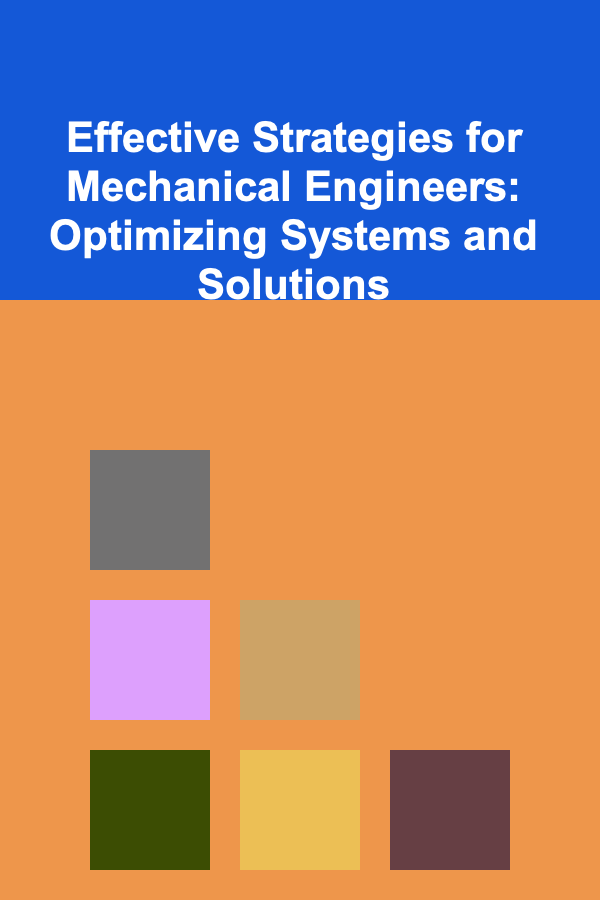
Effective Strategies for Mechanical Engineers: Optimizing Systems and Solutions
ebook include PDF & Audio bundle (Micro Guide)
$12.99$9.99
Limited Time Offer! Order within the next:

Mechanical engineering is a vast and dynamic field that encompasses the design, analysis, and optimization of mechanical systems. As technology advances, mechanical engineers are required to employ sophisticated techniques to solve complex problems efficiently and innovatively. Optimizing systems and solutions is a key aspect of mechanical engineering that can significantly improve performance, reduce costs, and enhance sustainability. This actionable guide outlines effective strategies for mechanical engineers, focusing on system optimization, design strategies, and problem-solving approaches.
Understanding the Core Principles of Optimization
Optimization is at the heart of mechanical engineering. Whether designing a new product, improving an existing system, or ensuring energy efficiency, optimization involves making the best possible use of available resources while meeting required performance standards.
1.1. Identify Key Objectives
The first step in optimization is to define the objectives. This could involve maximizing efficiency, minimizing weight, reducing cost, or improving durability. Without clear goals, optimization efforts may not be targeted, leading to inefficiencies or missed opportunities.
- Objective examples :
- Maximizing energy efficiency in HVAC systems.
- Minimizing manufacturing costs in product design.
- Enhancing performance in thermal systems (e.g., heat exchangers).
1.2. Understand Constraints
Every optimization problem has constraints --- whether they are related to material properties, budget, time, or environmental impact. Identifying and understanding these constraints is essential for formulating an optimization strategy. For example, a product's design may be limited by manufacturing processes or regulatory standards.
Actionable Tip: Create a list of constraints early in the design process. These could include dimensional limitations, cost caps, material selection restrictions, or environmental regulations.
1.3. Use Analytical Models
Optimization often relies on analytical models to simulate system behavior. Using tools such as Finite Element Analysis (FEA) for structural optimization, Computational Fluid Dynamics (CFD) for fluid flow optimization, or thermal analysis software for heat management is essential in modern mechanical engineering.
Actionable Tip: Leverage simulation tools early in the design phase to identify potential inefficiencies before physical testing, saving time and resources.
System-Level Optimization: Enhancing Overall Performance
At the system level, optimization focuses on improving how individual components work together to achieve higher overall efficiency. This could involve integrating various subsystems in machinery or refining how different processes are synchronized in manufacturing systems.
2.1. Holistic Design Approach
Mechanical engineers should adopt a holistic view when optimizing systems. Instead of focusing only on individual components, they must consider how each part interacts with others. For instance, in an automotive design, engineers must optimize the powertrain, suspension, aerodynamics, and even the software that governs the vehicle's performance.
Actionable Tip : When designing systems, always perform a system-level analysis to evaluate the interactions and interdependencies between components. This can be done through simulation software or physical prototypes.
2.2. Energy Efficiency
Energy efficiency is one of the most critical optimization areas, especially in industries where energy consumption accounts for a significant portion of operational costs. Mechanical engineers can optimize systems like pumps, compressors, turbines, and HVAC systems to reduce energy usage without compromising performance.
- Techniques :
- Variable-speed drives: Use them to adjust the power consumption based on demand.
- Heat recovery: In many systems, waste heat can be captured and reused, improving overall energy efficiency.
- Aerodynamic design: In automotive and aerospace engineering, optimizing the aerodynamics of vehicles can significantly reduce fuel consumption.
Actionable Tip: Regularly audit the energy performance of mechanical systems to identify areas where improvements can be made. Tools like energy simulation software can help pinpoint inefficiencies.
2.3. Lifecycle Analysis (LCA)
When optimizing a system or product, it's vital to assess not only its immediate performance but also its environmental impact over its entire lifecycle. This includes considering raw material extraction, manufacturing processes, usage, and end-of-life disposal.
- Example: In product design, using sustainable materials and considering energy consumption during the product's use phase can help reduce the environmental footprint.
Actionable Tip : Integrate Lifecycle Analysis (LCA) into the early design stages to ensure that long-term sustainability is part of your optimization efforts.
Design Optimization Techniques: Making Better Products
The design phase is where many optimization strategies are applied to mechanical systems. Engineers often work on enhancing the performance, durability, and manufacturability of products while reducing costs.
3.1. Topology Optimization
Topology optimization involves finding the best material distribution within a given design space to achieve a specific performance objective, often with constraints on mass, volume, or strength. It is especially valuable in structural design, where weight reduction without sacrificing strength is a critical goal.
- Applications: Aerospace components, automotive parts, and structural supports.
- Tools: CAD software that integrates topology optimization features (e.g., Autodesk Fusion 360, Dassault Systèmes' CATIA).
Actionable Tip: Use topology optimization early in the design process to explore alternative configurations that meet performance criteria while minimizing material usage.
3.2. Finite Element Analysis (FEA)
FEA is a computational technique used to predict how structures respond to external forces, temperature changes, and other physical effects. By applying FEA, engineers can optimize the design of components for durability, strength, and reliability.
- Applications: Structural components, pressure vessels, and heat exchangers.
- Benefits: It helps detect weak points in a design and reduce the need for physical prototypes, saving both time and money.
Actionable Tip: Perform FEA simulations regularly throughout the design process to ensure that the component can withstand operational conditions and avoid costly failures.
3.3. Design for Manufacturability (DFM)
Optimizing for manufacturability ensures that the design is not only functionally efficient but also easy and cost-effective to produce. This could mean designing for standardized parts, reducing complex geometries, or considering the limitations of the manufacturing process itself.
- Example: Simplifying a component's geometry to reduce machining time or using 3D printing to create parts with complex internal geometries that would be difficult or impossible to achieve with traditional manufacturing methods.
Actionable Tip: Work closely with manufacturing teams during the design phase to identify potential manufacturing challenges and ensure that the design is optimized for cost-effective production.
Problem-Solving and Troubleshooting in Mechanical Systems
Mechanical systems are often complex, and problems can arise at various stages, from design to operation. Engineers must be equipped with effective problem-solving strategies to diagnose issues, identify solutions, and implement corrective actions.
4.1. Root Cause Analysis (RCA)
When a mechanical system fails or underperforms, it's crucial to conduct a thorough root cause analysis to identify the underlying problem. This methodical approach helps prevent future issues by addressing the root cause rather than just the symptoms.
- Techniques :
- 5 Whys: Ask "why" multiple times to drill down to the root cause.
- Fishbone Diagram: Identify potential causes of the problem by categorizing factors (e.g., materials, processes, environment).
Actionable Tip: Develop a structured problem-solving framework that can be used across teams to ensure that problems are consistently diagnosed and addressed.
4.2. Predictive Maintenance
For systems that are already in operation, predictive maintenance is an optimization strategy that uses data and analytics to predict failures before they occur. By monitoring system performance through sensors and IoT technology, engineers can foresee when parts are likely to fail and replace them proactively.
- Applications: Industrial machinery, HVAC systems, automotive fleets.
- Tools: Vibration analysis, thermal imaging, and acoustic sensors can help predict failure points.
Actionable Tip: Implement a predictive maintenance system to monitor key performance indicators (KPIs) such as temperature, pressure, and vibration levels, and schedule maintenance before critical failures occur.
4.3. Continuous Improvement and Feedback Loops
Optimization isn't a one-time effort but an ongoing process. Mechanical engineers should foster a culture of continuous improvement, where designs and systems are regularly reviewed, tested, and enhanced based on real-world feedback.
- Techniques :
- Kaizen: Implement incremental improvements in design and processes.
- Lean Manufacturing: Eliminate waste and inefficiencies in production systems.
Actionable Tip: Set up regular review cycles to evaluate the performance of mechanical systems, gather feedback from end-users, and integrate lessons learned into future projects.
Staying Ahead of Emerging Trends
The field of mechanical engineering is rapidly evolving, with new technologies and methodologies continuously emerging. Staying updated on the latest advancements and integrating them into optimization strategies can provide a competitive edge.
- Additive Manufacturing (3D Printing): Revolutionizing part design and production.
- Artificial Intelligence (AI) and Machine Learning: Automating optimization processes and improving predictive maintenance.
- Sustainable Engineering: Increasing emphasis on environmental impact, using renewable energy sources, and designing for recyclability.
Actionable Tip: Attend conferences, participate in webinars, and subscribe to industry journals to stay informed about the latest technologies and best practices in mechanical engineering.
Conclusion
Optimizing systems and solutions is fundamental to the work of mechanical engineers. By embracing strategies such as holistic design, energy efficiency, and advanced simulation tools, engineers can create innovative, cost-effective, and sustainable solutions. The key to success lies in a deep understanding of the systems being optimized, a methodical approach to problem-solving, and a commitment to continuous improvement. By implementing these strategies, mechanical engineers can stay ahead of the curve and drive meaningful advancements in their field.
Reading More From Our Other Websites
- [Soap Making Tip 101] Silicone vs. Plastic: Which Soap Mold Material Delivers the Best Results?
- [Organization Tip 101] How to Implement a Daily Workspace Cleaning Routine
- [Stamp Making Tip 101] From Blank to Brilliant: How to Select the Right Rubber for Custom Stamps
- [Organization Tip 101] How to Organize Pet Medications and Health Records
- [Home Staging 101] How to Declutter and Stage Your Home for Maximum Appeal
- [Organization Tip 101] How to Store Towels Efficiently: Folding and Rolling Techniques
- [Biking 101] Bike Mirrors: A Simple Upgrade for Safer Cycling
- [Home Security 101] How to Secure Your Home's Wi-Fi Network from Hackers
- [Home Renovating 101] How to Design the Perfect Outdoor Kitchen for Year-Round Entertaining
- [Personal Care Tips 101] How to Choose a Deodorant That's Free from Harsh Chemicals

Budget-Friendly and Exciting Affordable Children's Party Ideas for Any Occasion
Read More
How to Create a System for Managing Family Activities
Read More
How to Keep Your Appliances Running Smoothly with Regular Care
Read More
How to Set Up a Stunning DIY Photo Booth for Your Home Party
Read More
How to Soundproof Your Windows Using Cheap and Effective Materials
Read More
How to Discover the Cities of Pompeii and Herculaneum
Read MoreOther Products

Budget-Friendly and Exciting Affordable Children's Party Ideas for Any Occasion
Read More
How to Create a System for Managing Family Activities
Read More
How to Keep Your Appliances Running Smoothly with Regular Care
Read More
How to Set Up a Stunning DIY Photo Booth for Your Home Party
Read More
How to Soundproof Your Windows Using Cheap and Effective Materials
Read More